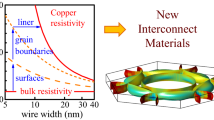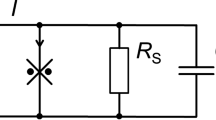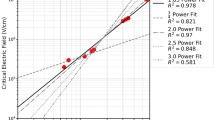Abstract
High-temperature superconducting (HTS) tapes currently used for the manufacture of resistive fault current limiters use metallic substrates upon which the HTS film is grown. Because the alloys used for these substrates, such as Hastelloy, have a rather high resistivity and low thermal conductivity, the HTS film must be protected by a more conducting metallic layer acting as a shunt to avoid burn out during a fault. This shunt layer limits severely the electric field generated during the fault to values smaller than 100 V/m. A long length of tape is then necessary to achieve the desired high voltage. We show here that by using a high thermal diffusivity dielectric substrate such as sapphire, it is possible to obtain much higher electric fields of up to several kilovolts per meter.
Similar content being viewed by others
1 Introduction
Second-generation high-temperature superconducting (HTS) tapes comprise a high-resistivity low thermal conductivity metallic substrate such as Hastelloy, buffer layers, a RBCO film and a stabilizing metallic layer acting as a shunt. This architecture is well suited for applications such as superconducting cables, transformers, and high magnetic field coils. However, it is not well suited for superconducting fault current limiter (SFCL) applications. This is because the highly conductive shunt layer prevents the development of the desired high electric field when a fault triggers the return of the SFCL to the normal state. The electric field reached in state-of-the-art HTS tapes used for SFCL applications is then limited to 100 V/m. We show here that by replacing the low thermal conductivity substrate currently used by a high thermal conductivity, high-diffusivity dielectric substrate, it is possible to achieve electric fields of several kilovolts per meter, and that the maximum power that can be dissipated per unit area of the tape without burn out can be increased by more than one order of magnitude.
2 Architecture and Operation of a Dielectric-Based SFCL Element
We consider a tape architecture comprising a dielectric substrate of thickness h, having a (high) thermal conductivity \(K(T)\) and a heat capacity \(C_{\mathrm {p}}(T)\), a thin buffer layer allowing an ideal thermal contact with the substrate, an HTS film having a critical current per unit width \(I_{\mathrm {c}}\), and a thin shunt layer having a resistance per square \(R_{\mathrm {\Box }}(T)\), of negligible thermal conductance and heat capacity. As will be shown below, a thin shunt later is sufficient when the substrate has a high diffusivity.
When fault occurs, a current exceeding the critical current flows through the SFCL composite element as it returns to the normal state and the element starts to heat up. Empirical evidence shows that the time it takes to return to the normal state (τs) is of the order of 1 ms. After about 100 ms, a mechanical device is activated and current stops flowing through the SFCL element. We assume that on these time scales, heating is adiabatic because heat exchange between the SFCL element and the surrounding cryogen is negligible. In order to avoid damaging the HTS layer, the temperature should not exceed a certain maximum value temperature (TM) of the order of 400 K, to be on the safe side [1].
Because in the considered architecture the shunt layer is very thin, its thermal conductance and heat capacity are negligible compared with those of the substrate. The dissipated heat flows primarily to the substrate which controls the heating rate and therefore the maximum power that can be dissipated without overshooting the allowed maximum temperature \(T_{\mathrm {M}}\) within a set time. The shunt layer on the other hand controls through its resistance \(R_{\mathrm {\Box }}(T)\) the maximum electric field that can develop before \(T_{\mathrm {M}}\) is reached.
3 The Role of the Substrate Diffusivity
The rate at which a heat front progresses is governed by the thermal diffusivity \(D = K/C:\)
Over the switching time scale \((\tau _{\mathrm {s}})\), the heat front moves a distance:
Sapphire is a specific example of a dielectric substrate having a high diffusivity. At 65 K, below the critical temperature of the HTS layer, its value is about 100 cm2/s. If a hot spot develops because of the presence of some defect in the HTS layer, within 1 ms, the temperature increase of the substrate is smoothed out over the length scale \(\delta = 3\) mm, which is of the order of a typical tape width. The heat front also penetrates to that depth into the substrate. By comparison, the thermal diffusivity of Hastelloy is only 0.03 cm2/s and \(\delta = 50~\mu \)m.
The heat penetration depth \((\delta )\) determines the maximum effective thermal thickness of the SFCL element, and hence the maximum effective heat capacity and the lowest possible rate of temperature increase for a given power \((p)\). The larger \(\delta \), the thicker the substrate one can use and the slower this rate can be. A SFCL element based on sapphire will heat up less at a given time than one based on Hastelloy, and as a result will be able to withstand a larger power. We note that \(\delta \) is not strongly time dependent. This is because at long times, the element heats up and the diffusivity reduces. For sapphire, \(\delta \) remains close to 3 mm from 1 ms, the time scale that characterizes the transition to the normal state, to 100 ms which is the time at which a mechanical device will cut the fault current and heating will stop.
4 Maximum Power
When a SFCL element is submitted to an applied ac voltage \((V)\) over a length scale equal to the width of the tape, the power dissipated per unit area upon return to the normal state is given by:
The rate of temperature increase is given by:
where h is limited to the value of \(\delta \) calculated above. The maximum power allowed will be:
where \({\Delta }T\) is the maximum allowed temperature increase and \(t_{\mathrm {m}}\) is a time scale that can range from \(\tau _{\mathrm {s}}\) if immediate burn out is to be avoided to the time at which the mechanical switch is operated. In fact, the shortest time scale at which the ac power is defined is half a cycle or 10 ms. In what follows, we will use this time scale and take \({\Delta } T =\) 300 K.
In the case of sapphire, the heat capacity is strongly temperature dependent, ranging from 0.4 J/cm3 around 90 K to 2.8 J/cm3 at room temperature. Taking a value of 1 J/cm3, and \(\delta =\) 0.3 cm, we get a maximum power of 9,000 W/cm2.
For comparison for a Hastelloy substrate, using a room temperature heat capacity value of 2.7 J/cm3 and \(\delta = 50 \mu \)m, we get a maximum power of 400 W/cm2.
These values compare reasonably well with published data. For sapphire, Kraemer et al. gives a maximum power of 1200 W/cm2 [2], Yamasaki et al. at 1700 W/cm2 [3], while for Hastelloy-based tapes, reported values are of the order of 100 W/cm2 [4].
5 Shunt Optimization for Achieving Highest Possible Electric Field
While the maximum power is basically a property of the substrate, the maximum electric field that can be achieved is also determined by the shunt resistance. The critical current of the HTS layer needs also to be taken into account.
For a given value of the maximum power, the voltage over a length equal to the width of the tape is given by:
However, we have to take into account that when a fault occurs, the current that flows through the shunt is at least equal to the critical current and the voltage that develops is at least equal to \(R_{\mathrm {\Box }}(T)I_{\mathrm {c}}\). We have to make sure that:
The highest value of \(R_{\mathrm {\Box }}(T)\) that is allowed is \(p_{\mathrm {M}}/I_{\mathrm {c}}^{\mathrm {2}}\), and the maximum electric field that can be reached without damaging the tape is:
For a critical current of 300 A/cm-w, the maximum electric field that can be achieved will be 3 kV/m for a sapphire-based tape and 130 V/m for a Hastelloy-based tape.
6 Conclusions
By using thick dielectric substrates of high thermal diffusivity, such as sapphire, it is possible to make relatively short SFCL elements that can sustain high-power dissipation and high voltage.
Change history
16 June 2018
The original version of this article contains the following mistakes: On the second page 1st paragraph under heading “The Role of the Substrate Diffusivity” second and third sentences, 90 K, 300 cm2/s and 5 mm, should be replaced with 65 K, 100 cm2/s and 3 mm.
References
Tixador, P. In: Tixador, P. (ed.) : Superconducting fault limiters. World Scientific, Singapore (2018). (to appear)
Kraemer, H.P. et al.: IEEE Trans. Appl. Supercond. 13, 1988 (2003)
Yamasaki, H. et al.: Appl. Phys. Lett. 85, 4427 (2004)
Hobl, A. et al.: IEEE Trans. Appl. Supercond. 23, 5601804 (2013)
Acknowledgments
Useful discussions with Mishael Azoulay and Amir Saraf are gratefully acknowledged. This work has received funding from the European Union’s Horizon 2020 research and innovation programme under grant agreement No 721019 and from the Israel Ministry of Energy.
Author information
Authors and Affiliations
Corresponding author
Additional information
The original version of this article was revised: Corrections were made to the 1st paragraph under heading “The Role of the Substrate Diffusivity” and to the last sentence under heading “Shunt Optimization for Achieving Highest Possible Electric Field”. Full information regarding corrections made can be found in the erratum/correction article for this article.
Rights and permissions
Open Access This article is distributed under the terms of the Creative Commons Attribution 4.0 International License (http://creativecommons.org/licenses/by/4.0/), which permits unrestricted use, distribution, and reproduction in any medium, provided you give appropriate credit to the original author(s) and the source, provide a link to the Creative Commons license, and indicate if changes were made.
About this article
Cite this article
Deutscher, G. High-Voltage Superconducting Fault Current Limiters Based on High-Diffusivity Dielectric Substrates. J Supercond Nov Magn 31, 1961–1963 (2018). https://doi.org/10.1007/s10948-018-4633-8
Received:
Accepted:
Published:
Issue Date:
DOI: https://doi.org/10.1007/s10948-018-4633-8




